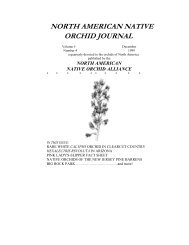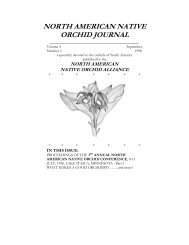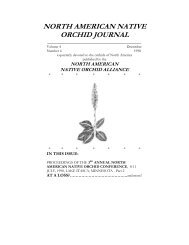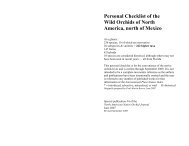north american native orchid journal - at The Culture Sheet
north american native orchid journal - at The Culture Sheet
north american native orchid journal - at The Culture Sheet
You also want an ePaper? Increase the reach of your titles
YUMPU automatically turns print PDFs into web optimized ePapers that Google loves.
Brown & Folsom: WILD ORCHIDS OF THE WHITE MOUNTAINS OF NEW HAMPSHIRE AND MAINE<br />
Spiranthes ochroleuca (Rydberg) Rydberg<br />
yellow ladies’-tresses<br />
Range: Michigan east to Nova Scotia, south to Kentucky<br />
and South Carolina<br />
In the White Mountains region: occasional to local<br />
Plant: terrestrial, 10-55 cm tall<br />
Leaves: 3-5; appearing basal or on the lower portion of the<br />
stem; linear-lanceol<strong>at</strong>e, up to 2 cm wide × 21 cm long;<br />
ascending to spreading; the leaves are present <strong>at</strong> anthesis<br />
Flowers: 10-50; in a spike, tight-to-loosely spiraled with 3-<br />
4(5) flowers per cycle, ascending; sepals and petals similar,<br />
lanceol<strong>at</strong>e; l<strong>at</strong>eral sepals appressed to petals and lip, straight;<br />
perianth white to cream-colored; lip oblong to ov<strong>at</strong>e, the<br />
central portion of the lip a deeper creamy yellow or<br />
butterscotch color, individual flower size 0.7-1.2 cm<br />
Habit<strong>at</strong>: dry to somewh<strong>at</strong> moist open sites, ledges, barrens,<br />
slightly wooded areas, grassy roadsides<br />
Flowering period: l<strong>at</strong>e August to September<br />
Typically, Spiranthes ochroleuca has a distinct butterscotchcolored<br />
trough in the center of the lip, something th<strong>at</strong> is<br />
very visible if one looks <strong>at</strong> the bottom side of the lip.<br />
Perhaps the very best areas to look for the yellow ladies’tresses<br />
are roadside scrapes and borrow pits. <strong>The</strong> plants<br />
often colonize such areas. <strong>The</strong>y usually occupy the drier<br />
portions and the nodding ladies’-tresses, S. cernua, often is<br />
found in the wetter areas. Such combin<strong>at</strong>ions are very<br />
helpful in comparing the species. Hybrids with S. casei are<br />
known as S.<br />
×borealis.<br />
258













